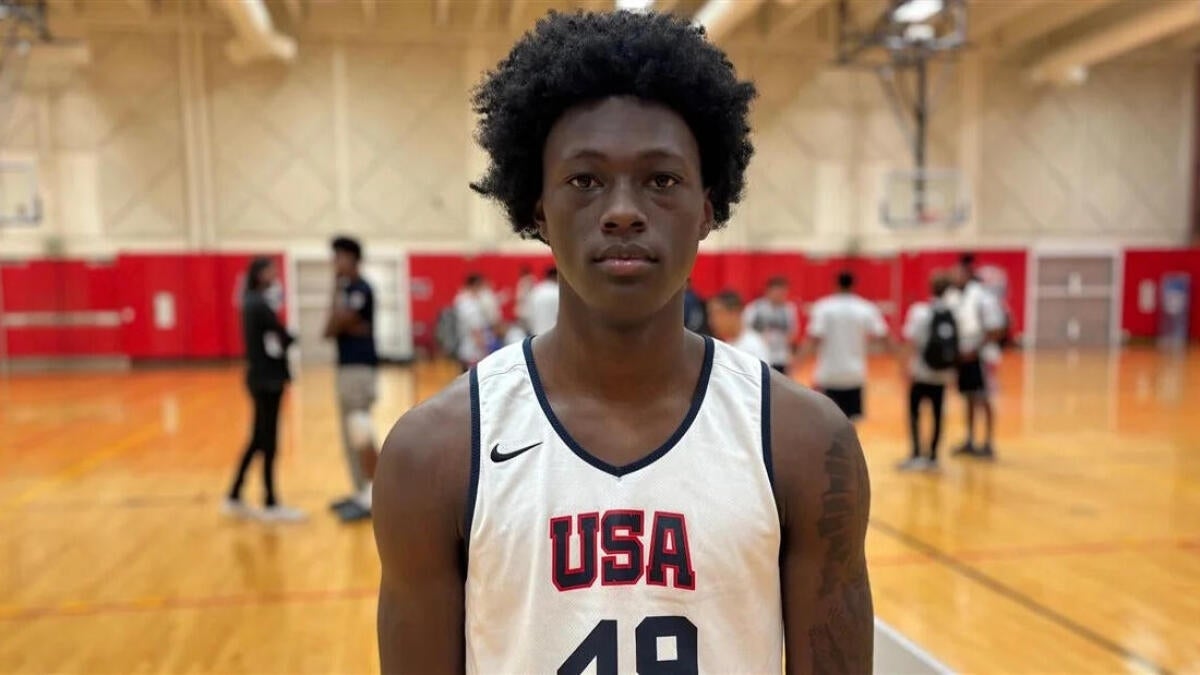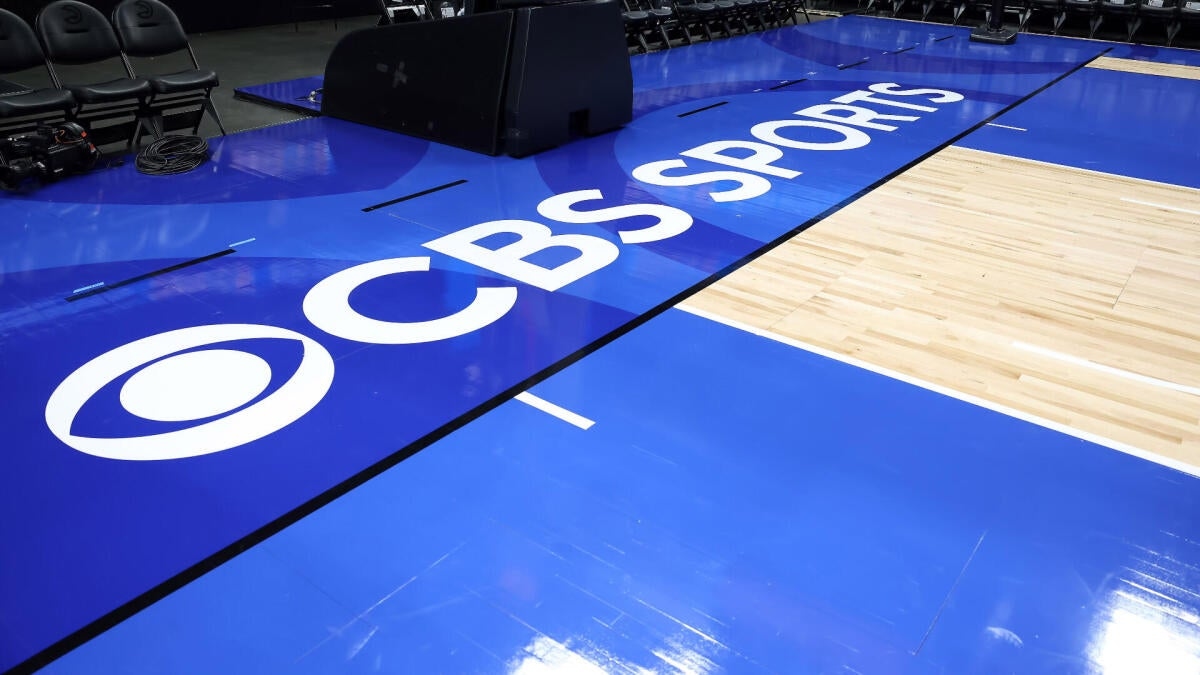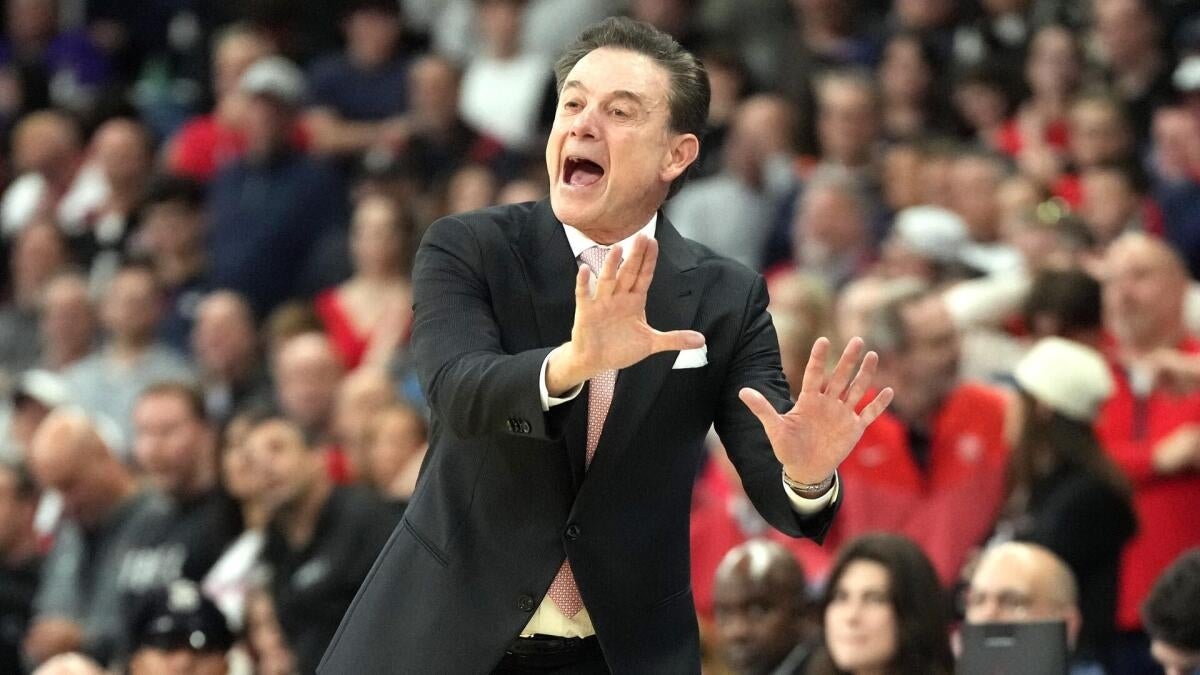Are set plays ruining the Premier League? How throw-ins are boosting Arsenal, but adding boredom

I'm just gonna put my cards on the table right away: I think using data is a good idea if you want to win more soccer games.
I know, I know. That might be shocking to hear, from the guy who wrote the book about soccer's fledgling analytics movement, the one who has moderated the soccer panel at the Sloan Sports Analytics Conference in each of the past few years, the person who has probably written the word "expected" (as in, expected goals and expected assists) more than a thousand times for the website you're currently reading.
One of the main advantages of trying to use objective information to improve your soccer club's decision-making is that most of the American sports are much further ahead. If you want it, they provide a rare kind of vision of the future: you can study the teams who did it right in other sports, and you can steal their ideas. The answers to the test are available, and you won't get punished for looking at them.
But American sports also offer up their own warnings, to the negative consequences when there is league-wide adoption of data-driven decision-making. Veteran players have been squeezed out of the workforce as teams have become more attuned to how aging affects performance.
In baseball, where just about every club is run by some guy with an Ivy League degree and every club is making decisions backed up by more data than any soccer club could ever imagine, the big-name players just below the superstar tier now command less money on the open market. That's because teams have gotten so good at measuring minute details like the launch angle of the bat and the spin rates created by a pitcher's grip that they can just look for cheaper players they know they can fix.
Soccer isn't close to reaching that point. And if anything, players are using data to gain an advantage in contract negotiations over clubs who still mostly either still view numbers with outright hostility or just use them in order to justify their own opinions.
But there is one area where soccer is occasionally resembling the fully optimized world of Major League Baseball. Teams are slowly beginning to value non-traditional techniques to score more points: free kicks, corners, and throw-ins. And if everyone eventually follows suit, it might ruin the sport.
- Ranked: All 87 national teams that can win '26 World Cup - All 20 Premier League teams re-ranked again - O'Hanlon: How to fix Man United in four steps
How Moneyball ruined baseballThere's always been a fraught relationship between what it means to win and what it means to entertain. That's especially true in soccer, where coaches like Jurgen Klopp have openly spoken about their responsibility to produce something that enthralled the people in the stands, while others like Jose Mourinho seemed to derive a perverse kind of joy in winning matches by using methods that made viewers unhappy.
But it's not just true in soccer -- it's true in every sport. These billion-dollar organizations that employ people to play games for a living need to entertain. If they're not entertaining fans, then the fans won't pay to watch them play, and if the fans don't watch them play, then these teams are no longer worth billions of dollars. And if they're not worth billions of dollars, then why are we so concerned with the cold-blooded science of discovering more wins, anyway?
This isn't just a thought experiment, either. It literally happened in baseball. Everyone built up massive front offices, staffed by all kinds of quantitative and physics geniuses, and everyone was doing whatever they could to eke out an extra couple wins. Baseball was invented by some dudes in the 1800s who were tired of playing cricket -- it was not designed to hold up against the rigorous scrutiny of rocket science.
And so, everyone in baseball realized that their teams would be better if their pitchers threw more strikeouts because that eliminated the randomness of what happened once the ball left the bat. At the same time, everyone in baseball also realized that walks were being undervalued because they weren't counted in batting-average statistics. On top of that, they encouraged players to try to hit more home runs since that, too, eliminated the randomness of the ball being in play.
But once everyone started following these fundamental ideas, baseball became something totally different. Gone was the uncertainty of what might happen once the ball hit the ground and players tried to round the bases. And it was replaced by a game that wasn't black and white, but rather black, white, and red: most at-bats ended with a walk, a strikeout, or a home run. Everyone else just stood around while the hitter, pitcher, and catcher seemingly played their own game.
It got so bad that MLB hired Theo Epstein, the former data-whiz general manager of the Boston Red Sox -- who are owned by Fenway Sports Group, the owners of Liverpool -- to change the rules of baseball to make it fun again. One of the guys who broke baseball now had to fix it. Changes were made to speed up games that had slowed down during the walks-strikeouts-or-homers era, and other tweaks were enacted to encourage more balls in play and more baserunners on the base paths. It seems like it's worked -- the 2025 MLB playoffs have been the most-watched since 2010.
If everyone in England realizes just how valuable set pieces and throw-ins actually are, could the Premier League find itself in a similar situation?
Why set pieces are so valuableAlmost all of the analytical breakthroughs across the major sports are obvious in retrospect: walks count the same as hits, a three-point shot is worth more than a two-point shot, and touchdowns are worth more than field goals.
Soccer's version of this might be what we've learned from the emergence of the advanced stat xG, or expected goals: it's easier to score when you shoot the ball from closer to the goal. Look at how far -- or, er, close -- we've come:
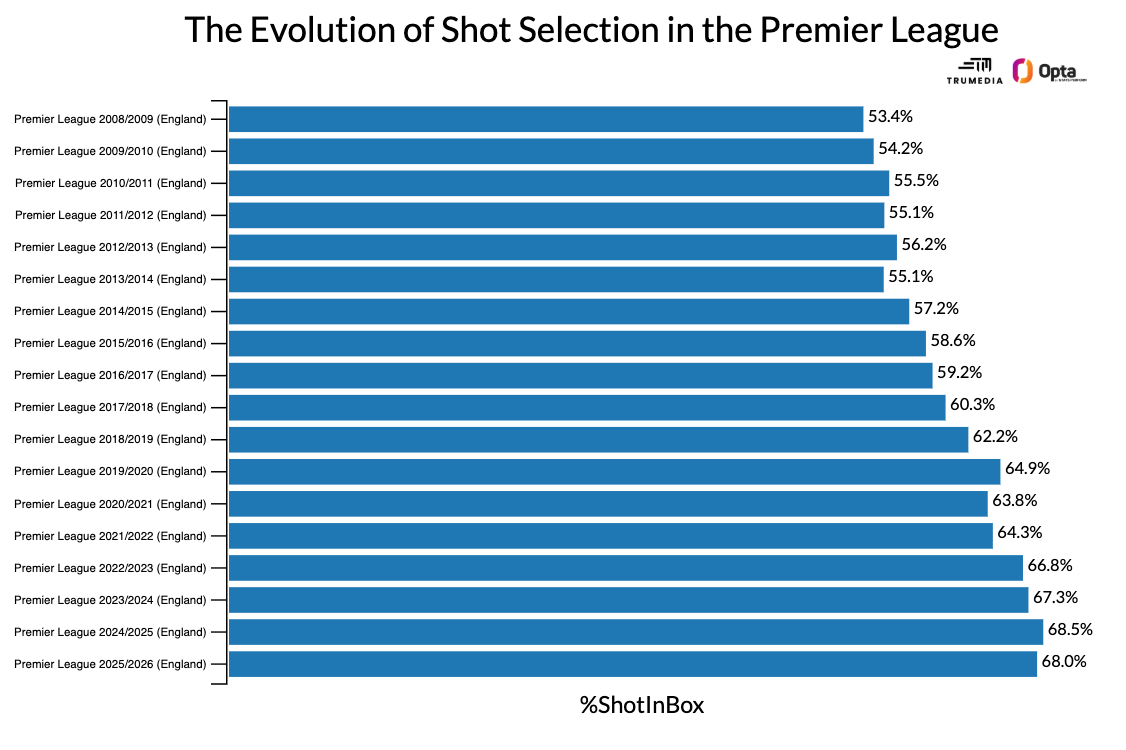
This, though, isn't a bad thing. While it's true that we don't get the kinds of laser beams that populated "Goal of the Month" videos back in 2006, better shot selection leads to a better entertainment product. For every swerving Michael Essien asteroid that pings off the post and into the goal, we have to suffer through 20 others that end up in the stands. Plus, I'm not convinced this is even an analytically driven development: it's just an outcome of tactical ideas that happens to match up with received analytical wisdom.
That's not the case with set pieces, though: I'm talking about corners, free kicks, and throw-ins. Nerds have been extolling the virtues of dead balls for a long time now. I've been writing about them for this website since the 2010s and while this doesn't feel like an "analytical" idea, per se, the value of set pieces has been confirmed by data analysis and real-life events.
Back in 2014-15, the Danish club FC Midtjylland, then owned by current Brentford owner Matthew Benham, scored 25 set-piece goals while no other team in the league scored 12. Midtjylland won their first-ever league title. A few years later, Midtjylland won the league again and scored 25 set-piece goals again. But this time around, the rest of the league had caught up: two other clubs scored 20-plus, and eight other clubs broke double-digits.
For a long time, coaches ignored set plays because, they argued, that spending time practicing set plays would take away from practicing possession play, and so any set-play improvement would be offset in a decline from open-play. Except, that's not what happened in Denmark. The number of set-piece goals increased from 0.55 in 2014-15 to 0.75 in 2017-18. But the number of goals also increased, from 2.41 per game to 2.91.
"It pointed to a huge under-exploited tactical wrinkle in the game that could help teams score enough goals to win a title," Ted Knutson, who helped design Midtjylland's set-piece program, told me. "And it's repeatable across the entire sport. That's a pretty big deal."
Even without teams committing to set-piece excellence like they were doing up in Denmark, there was still evidence that even mediocre set plays could yield results. In 2018, Paul Power published a paper titled "Mythbusting Set-Pieces in Soccer" at the Sloan Sports Analytics Conference. One of the findings: open-play possessions led to goals 1.1% of the time, while teams scored goals from 1.8% of their set plays.
Arne Slot reflects on Liverpool's latest performances and explains why Federico Chiesa is not on the squad ahead of Galatasaray clash.
"You're basically doubling your odds of scoring if you have taken a shot from a set piece," Power, who now works for SkillCorner, an analytics company that specializes in broadcast tracking data, told me.
This, too, seems obvious. Every open play goal is a small miracle -- each one requires so much technical and physical and mental precision from the team in possession. They're not running a play; they're creating a solution on the fly, and they have to do it without using their hands. The defense doesn't know what the attackers are doing, but the attackers also don't know what the other attackers are doing.
Set plays, though, are different. The game stops and the team has the opportunity to run a pre-planned play. The defense doesn't know what's coming, but all of the attackers suddenly know exactly what all of their teammates are going to do. While most of a soccer match is a mishmash of random events caused by a bouncing ball and our misshapen feet, dead balls are the one time where the attacking team gets to execute a specific, coordinated plan. The ball stops moving, and the defenders aren't allowed to pressure the passer.
If you have a decent plan, who knows how far it might take you.
How set pieces turned Arsenal into title contendersThe team sitting atop the Premier League right now spent a lot of money on a striker this past summer. And Viktor Gyökeres just hasn't worked out so far: only two non-penalty goals through eight starts, without the underlying shot quantities or qualities that suggest it'll get much better.
But it doesn't matter because Arsenal already had another top-class center forward at the club -- and I'm not talking about Kai Havertz. Both Knutson and Power have compared the value of a great set-piece program to that of a great striker.
"Right now, the average team scores between 0.30 to 0.35 goals a game from set pieces," Knutson said back in 2019. "The best teams can bump this up to 0.75 to 0.80. That type of leap in production takes an average Premier League forward and moves them into the realm of Neymar, except without the transfer fee or the massive cost in wages."
Or as Power later put it: "We know from the research we've looked at that if you have a very good set-piece regime, that's basically the equivalent, in terms of goals, of spending £80 million on a striker."
Through eight matches this season, Arsenal have eight goals from set plays. Only Erling Haaland is averaging more goals per game than Arsenal Set Play. And this has been true for a couple years now. Last year, Arsenal scored 15 set-play goals -- no Arsenal player had more than nine. The year prior, they hit 20 set-play goals, and none of their players scored more than 10 non-penalty goals.
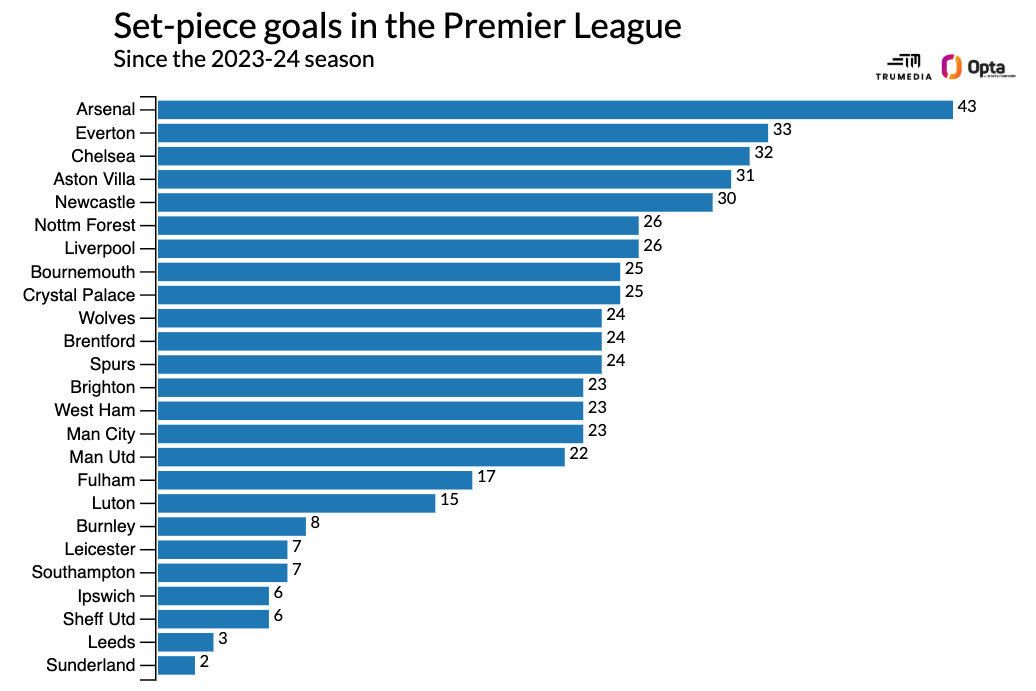
From open play, Arsenal score goals at the rate of a Europa League club, but their set-piece excellence elevates them to among the best teams in the world. Under manager Mikel Arteta, the Gunners have become an amazing defensive team filled with world-class defenders. They've gone nearly five straight hours of Premier League game time without allowing a shot on target.
When they have the ball, they're either hoofing it long from their goalkeeper David Raya or holding onto possession and working the ball forward in a slower, methodical way that rarely puts them at risk of getting counter-attacked.
It all works together in a virtuous cycle. Arsenal's set-piece prowess allows them to be more conservative and therefore so secure defensively, and the defensive security -- the fact that they don't concede many goals -- makes those set-piece goals especially valuable.
Liverpool under Jurgen Klopp were close to the polar-opposites of Arteta's Arsenal, but one of the main reasons they started to win titles and put up 90-plus point totals is that they started to take set pieces seriously. They led all of Europe's Big Five top leagues in set-piece goals during the 2018-19 season.
If you're not spending some time trying to figure out how to score 15 or 20 set-play goals in a season, then you're not doing everything you can to win.
Will set plays ruin the Premier League?What happens, though, when everyone is doing everything they can to win?
A big reason why there's been a running argument about "the right way to play" soccer is that the sport's tactics are all about trade-offs.
"I have talked in the past about the 'short blanket,'" said then-Newcastle manager Rafa Benitez once upon a time. "If you cover your head, you have your feet cold, but if you cover your feet, you have your head cold. Sometimes, when you attack so much, you are exposed in defense. To find the balance is key."
This often gets framed in moral or ethical terms, as if certain teams are fulfilling a grander ideal by trying to win games a certain way. I think part of the reason that happens is because people respect and connect, emotionally, with the teams that are willing to take lots of risks in order to score goals. We need those teams to make the narrative fabric of the sport interesting, but also just to make the games themselves interesting.
But what if everyone recognizes how valuable set plays are? Then what's the value in taking risks?
Mikel Arteta discusses Arsenal's impact from corners and free kicks after they scored another winner from a set piece vs. Fulham.
If you're more likely to score from a corner kick than an open-play possession, what's the point of attempting a dangerous dribble through traffic or pushing both of your fullbacks up near the box to try to create more space near the goal? Aren't you better off just trying to keep the ball away from your opponent so they can't create their own set plays? And shouldn't you just slowly work the ball into the attacking third, maybe draw a foul, possibly win a throw-in, or at worst attempt a low-risk shot from far out with the hope that it hits someone and goes out for a corner kick? And if you can't do that, just kick it long, contest the 50-50, and hope you draw a foul that way?
If this line of thinking takes hold, then not only does the game that thrilled the world because of its dynamic free-flowing nature suddenly center around set pieces, but with everyone trying to draw set pieces through fouls, there would simply just be less of the game itself. A growing proportion of each 90-minute match would get taken up by teams standing around, discussing what play to run, or waiting for the guy with the ball in his hands to launch it into the box.
If that's what soccer had always looked like, then I wouldn't be getting paid to write about soccer for a living, and the Premier League's television deal wouldn't be worth billions of dollars. But over the first eight weeks of this season, the Premier League really has started to look a little like this. Teams still aren't using data to make personnel or tactical decisions at any kind of scale, but set pieces seem as important as they've ever been.
While quantifying entertainment quality is a fool's errand -- if people enjoy it, they enjoy it, and vice versa -- most people would agree that a given sport is in a healthy place when there's a lot of action: the ball is moving a lot, and there are plenty of attempts on goal.
In the current Premier League season, teams are averaging 429 pass-attempts per game, the lowest number on record since the 2010-11 season. And they're attempting 12.1 shots per game, the lowest number in the Stats Perform database, which goes back to the 2008-09 season.
A big reason why: the ball is rarely in play. Coming into this past weekend's games, according to Stats Perform, the ball had been in play for just 54% of the allotted game time. Over a full season, that would be the lowest mark of the past 10 seasons.
And a big reason why the ball is rarely in play: more and more teams are prioritizing set plays. Especially throw-ins. Rather than quickly throwing the ball in and re-starting play, a growing number of clubs are launching balls into the box, turning what used to be a harmless re-start into another chance on goal. And to throw the ball into the box, you need to move everyone into the box, figure out what play you're running, and then wait for the guy to throw the ball.
Through eight games, there have been more shots from throw-ins than in any season on record. And yes, for the true sickos out there, the first two seasons in the chart below have so many throw-in shots because Rory Delap was still playing for Stoke City:
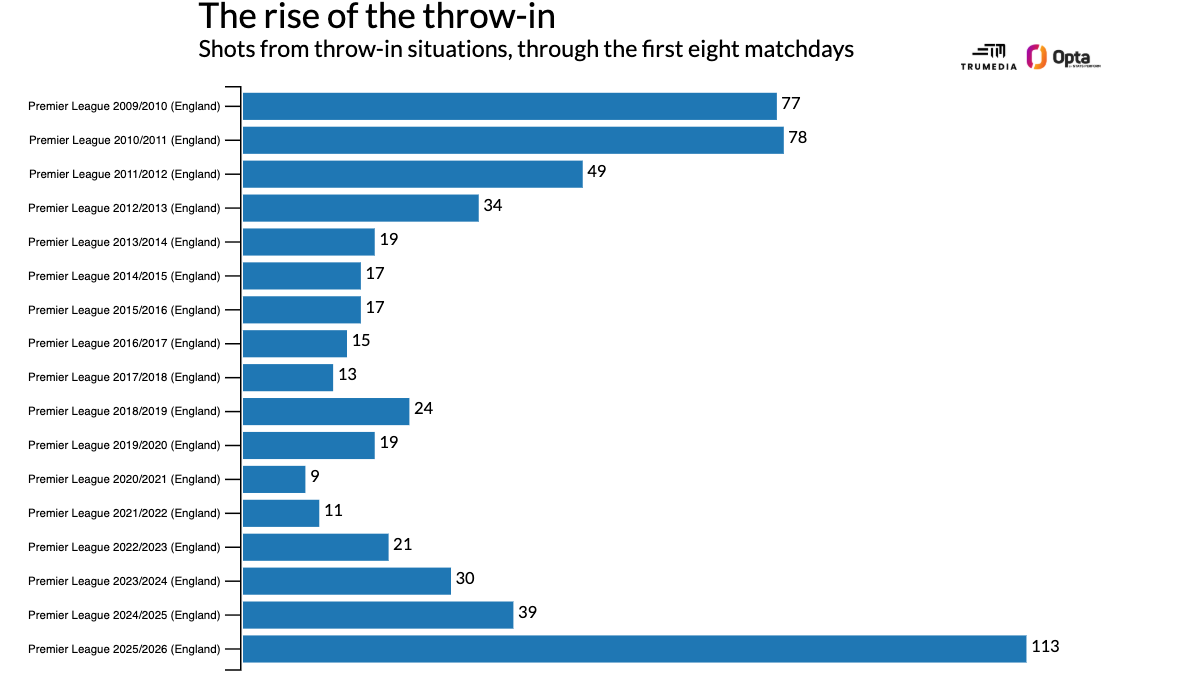
Despite all these new attempts being generated from throw-ins, the Premier League as a whole has not been able to replicate the Danish experiment. No, instead, there's been a rise in set-piece goals, but those goals haven't been added on top of what we already had.
The set-play goals have mostly just replaced open-play goals. This season ranks dead last in the dataset for open-play goals through the first eight weeks:
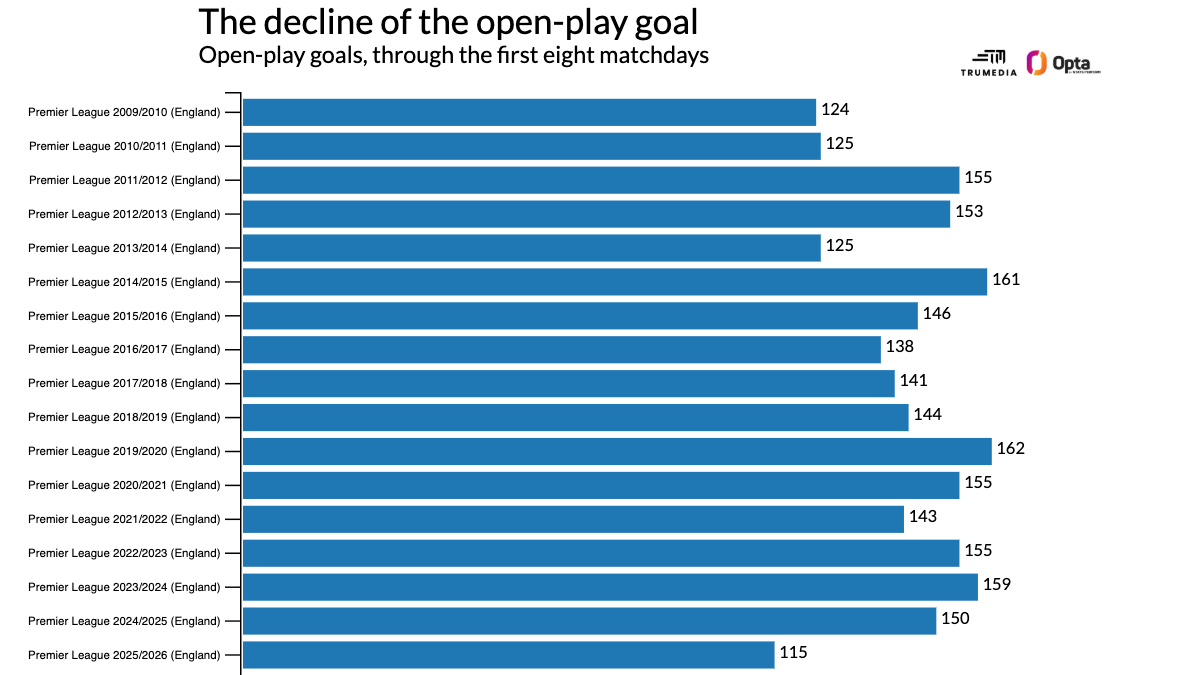
So, we've all just spent the past couple months watching a season where the ball is rarely in play. We're seeing fewer passes than at any point in the current era. We're seeing fewer shots than in any recorded season, and most of the goals we're seeing aren't coming from moments of individual brilliance or team-wide telekinesis. No, they're coming from someone launching the ball into the box with their hands or from a well-designed set piece that allows a gigantic center back to overpower the opposition.
Chances are, things will start to shift back at some point. Last season, Premier League clubs scored a record number of goals, and then they spent hundreds of millions of dollars on brand-new attacking talent. The best explanation for the lack of open-play scoring is just that: so many teams have new attackers, and so maybe it's just going to take some time for these players to figure out how to play together.
Maybe we really do reach the end of the season and we all agree that Erling Haaland is the only world-class attacker in the Premier League. He's currently the only one playing at that level, but it's hard to believe that a league that was so good and so deep last season just suddenly seems bereft of star creators and goal-scorers. So often teams and players fix their problems by just ... playing better, and there are lots of players, up and down the league, who could suddenly do just that.
But at the same time, the increased emphasis on set pieces is going away. Throw-ins have suddenly become a widely accepted weapon almost overnight. And Arsenal are currently the best team in the league with greater than 50% odds to win the title. The gap between the Gunners' open-play production and their overall quality as a team is going to make it hard for the rest of the league to ignore just how valuable these situations are. Most experts think we still have a lot of space between where things currently are and where the optimal level of execution and implementation sits.
So, it's not just that set pieces are here to stay -- they're likely going to become even more widespread over the coming seasons. And if that happens, let's hope that those open-play goals re-appear and the Premier League looks more like Denmark: where set-play goals are an added competitive advantage, and they don't replace the kinds of goals that make soccer worth watching in the first place.
If they do, and if the current state of things become the permanent state of things, then someone at the Premier League is going to have to give Theo Epstein a call.
espn

